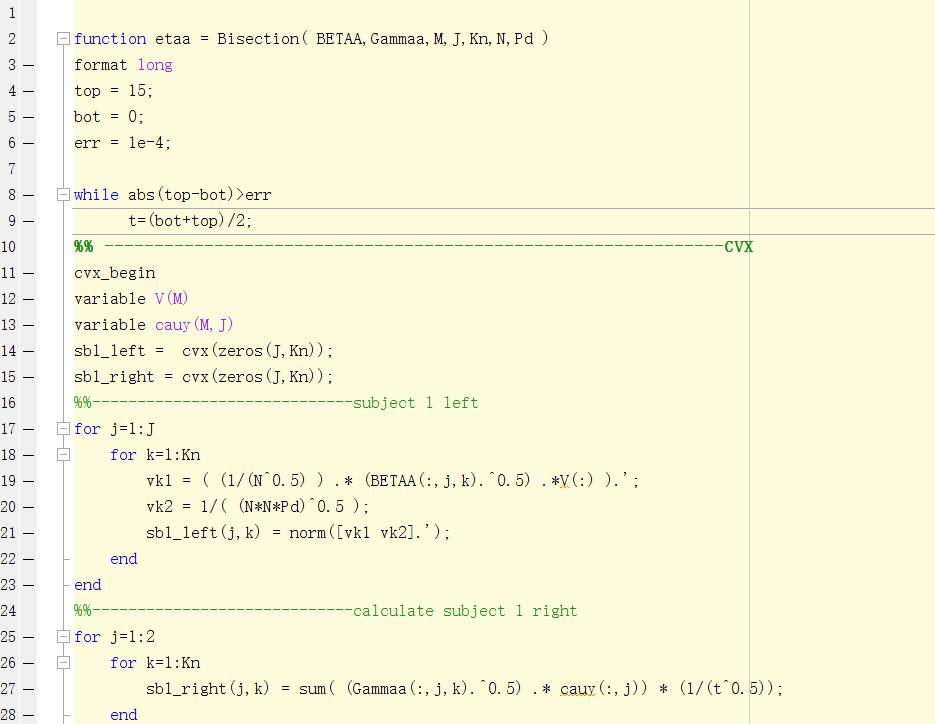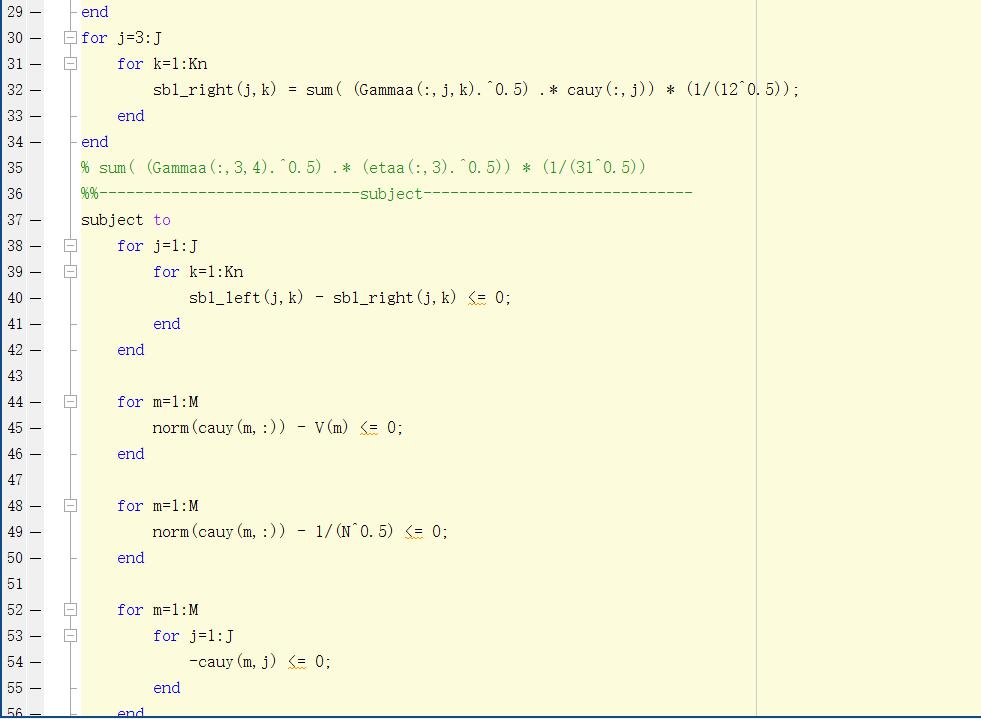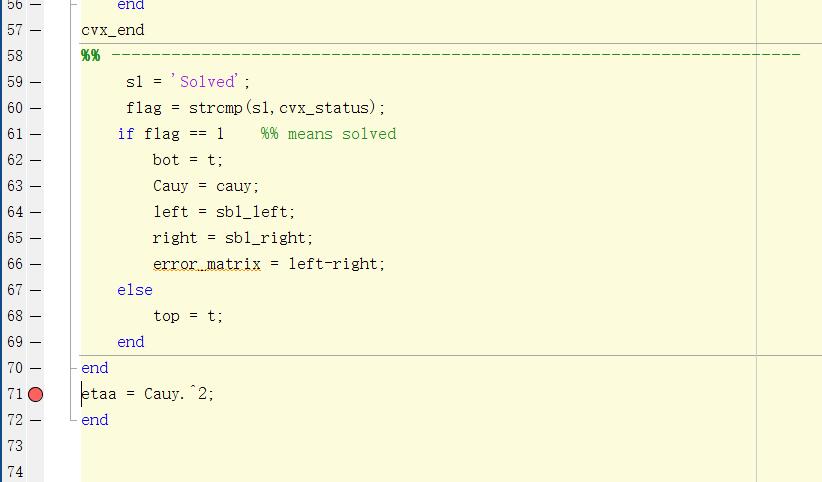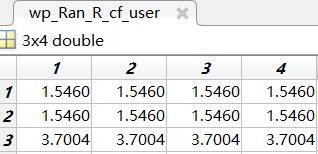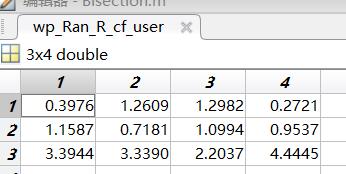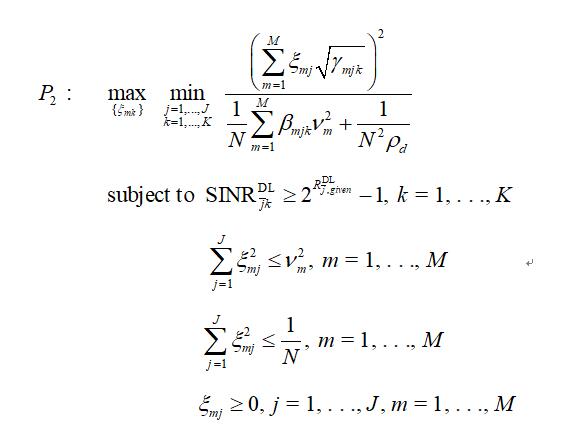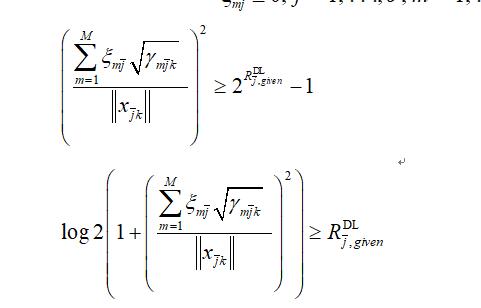Hi, I want to use CVX to solve this problem:
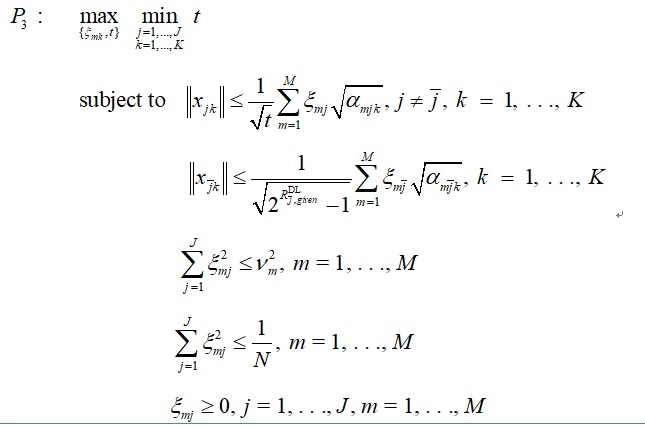
The first and second constraints are SOCP constraints. My Matlab codes are as follow:
But I met some problems. When the CVX told me that P3 was solved, I verified the first and the second constraints in P3. But it is wrong. In my code I let sb1_left(j,k) - sb1_right(j,k) <= 0 for any j and k, but I found sometimes sb1_left(j,k) - sb1_right(j,k) >=0. It was not satisfied my constraints, but CVX solved my problem. What is the reason for this? Can anyone help me? Thank you all. Next is my experiment information
Calling SDPT3 4.0: 786 variables, 192 equality constraints
For improved efficiency, SDPT3 is solving the dual problem.
num. of constraints = 192
dim. of socp var = 624, num. of socp blk = 72
dim. of linear var = 162
SDPT3: Infeasible path-following algorithms
version predcorr gam expon scale_data
NT 1 0.000 1 0
it pstep dstep pinfeas dinfeas gap prim-obj dual-obj cputime
0|0.000|0.000|1.5e+02|6.0e+01|2.7e+04| 1.897367e+01 0.000000e+00| 0:0:00| chol 1 1
1|0.166|0.350|1.2e+02|3.9e+01|1.8e+04| 6.673415e+01 0.000000e+00| 0:0:00| chol 1 1
2|0.854|0.787|1.8e+01|8.4e+00|3.8e+03| 1.388879e+02 0.000000e+00| 0:0:00| chol 1 1
3|0.972|0.979|5.2e-01|1.7e-01|2.2e+02| 1.412998e+02 0.000000e+00| 0:0:00| chol 1 1
4|0.987|0.971|6.8e-03|5.2e-03|1.1e+01| 1.051068e+01 0.000000e+00| 0:0:00| chol 1 1
5|0.958|0.758|2.9e-04|2.2e-03|6.3e-01| 4.940575e-01 0.000000e+00| 0:0:00| chol 1 1
6|0.927|0.783|1.3e-04|5.3e-04|6.7e-02| 4.093017e-02 0.000000e+00| 0:0:00| chol 1 1
7|0.922|0.567|1.4e-04|2.5e-04|2.1e-02| 7.979816e-03 0.000000e+00| 0:0:00| chol 1 1
8|1.000|0.690|8.2e-05|8.4e-05|6.8e-03| 2.965152e-03 0.000000e+00| 0:0:00| chol 1 1
9|1.000|0.628|3.1e-05|3.4e-05|2.5e-03| 1.146522e-03 0.000000e+00| 0:0:00| chol 1 1
10|0.996|0.686|1.3e-07|1.3e-05|7.0e-04| 3.065867e-04 0.000000e+00| 0:0:00| chol 1 1
11|0.629|0.537|4.9e-08|5.9e-06|3.4e-04| 1.666027e-04 0.000000e+00| 0:0:00| chol 1 1
12|0.389|0.536|3.0e-08|2.8e-06|2.1e-04| 1.258209e-04 0.000000e+00| 0:0:00| chol 1 1
13|0.725|0.648|8.3e-09|9.8e-07|8.1e-05| 5.333198e-05 0.000000e+00| 0:0:00| chol 1 1
14|0.314|0.245|5.7e-09|7.4e-07|6.3e-05| 3.921027e-05 0.000000e+00| 0:0:00| chol 1 1
15|0.371|0.366|3.6e-09|4.7e-07|4.4e-05| 2.482283e-05 0.000000e+00| 0:0:00| chol 1 1
16|0.179|0.372|2.9e-09|3.0e-07|3.4e-05| 1.869079e-05 0.000000e+00| 0:0:00| chol 1 1
17|0.334|0.226|2.0e-09|2.3e-07|2.8e-05| 7.455391e-07 0.000000e+00| 0:0:00| chol 1 1
18|0.207|0.159|1.6e-09|1.9e-07|2.9e-05|-3.250328e-05 0.000000e+00| 0:0:00| chol 1 1
19|0.135|0.082|1.3e-09|1.8e-07|4.6e-05|-1.490227e-04 0.000000e+00| 0:0:00| chol 1 1
20|0.096|0.059|1.2e-09|1.7e-07|1.1e-04|-7.104855e-04 0.000000e+00| 0:0:00|
lack of progress in infeas
number of iterations = 20
primal objective value = 7.45539059e-07
dual objective value = 0.00000000e+00
gap := trace(XZ) = 2.80e-05
relative gap = 2.80e-05
actual relative gap = 7.46e-07
rel. primal infeas (scaled problem) = 1.96e-09
rel. dual " " " = 2.30e-07
rel. primal infeas (unscaled problem) = 0.00e+00
rel. dual " " " = 0.00e+00
norm(X), norm(y), norm(Z) = 5.5e+02, 2.0e+00, 3.0e+00
norm(A), norm(b), norm© = 2.2e+01, 1.0e+00, 2.7e+00
Total CPU time (secs) = 0.23
CPU time per iteration = 0.01
termination code = 0
DIMACS: 2.0e-09 0.0e+00 4.8e-07 0.0e+00 7.5e-07 2.8e-05
Status: Solved
Optimal value (cvx_optval): -7.45539e-07
Calling SDPT3 4.0: 786 variables, 192 equality constraints
For improved efficiency, SDPT3 is solving the dual problem.
num. of constraints = 192
dim. of socp var = 624, num. of socp blk = 72
dim. of linear var = 162
SDPT3: Infeasible path-following algorithms
version predcorr gam expon scale_data
NT 1 0.000 1 0
it pstep dstep pinfeas dinfeas gap prim-obj dual-obj cputime
0|0.000|0.000|1.5e+02|6.0e+01|2.7e+04| 1.897367e+01 0.000000e+00| 0:0:00| chol 1 1
1|0.166|0.350|1.2e+02|3.9e+01|1.8e+04| 6.673415e+01 0.000000e+00| 0:0:00| chol 1 1
2|0.854|0.787|1.8e+01|8.4e+00|3.8e+03| 1.388879e+02 0.000000e+00| 0:0:00| chol 1 1
3|0.972|0.979|5.2e-01|1.7e-01|2.2e+02| 1.412997e+02 0.000000e+00| 0:0:00| chol 1 1
4|0.987|0.971|6.8e-03|5.2e-03|1.1e+01| 1.051073e+01 0.000000e+00| 0:0:00| chol 1 1
5|0.958|0.758|2.9e-04|2.2e-03|6.3e-01| 4.940283e-01 0.000000e+00| 0:0:00| chol 1 1
6|0.928|0.783|1.3e-04|5.3e-04|6.7e-02| 4.087132e-02 0.000000e+00| 0:0:00| chol 1 1
7|0.924|0.567|1.4e-04|2.5e-04|2.1e-02| 7.875375e-03 0.000000e+00| 0:0:00| chol 1 1
8|1.000|0.691|8.2e-05|8.4e-05|6.8e-03| 2.932572e-03 0.000000e+00| 0:0:00| chol 1 1
9|1.000|0.628|3.1e-05|3.4e-05|2.5e-03| 1.139125e-03 0.000000e+00| 0:0:00| chol 1 1
10|0.998|0.686|6.6e-08|1.3e-05|7.0e-04| 3.031507e-04 0.000000e+00| 0:0:00| chol 1 1
11|0.612|0.543|2.6e-08|5.8e-06|3.4e-04| 1.686080e-04 0.000000e+00| 0:0:00| chol 1 1
12|0.387|0.548|1.6e-08|2.6e-06|2.0e-04| 1.269612e-04 0.000000e+00| 0:0:00| chol 1 1
13|0.719|0.642|4.4e-09|9.5e-07|8.1e-05| 5.357841e-05 0.000000e+00| 0:0:00| chol 1 1
14|0.300|0.236|3.1e-09|7.3e-07|6.4e-05| 3.979369e-05 0.000000e+00| 0:0:00| chol 1 1
15|0.361|0.365|2.0e-09|4.6e-07|4.5e-05| 2.533710e-05 0.000000e+00| 0:0:00| chol 1 1
16|0.176|0.360|1.6e-09|3.0e-07|3.5e-05| 1.895349e-05 0.000000e+00| 0:0:00| chol 1 1
17|0.322|0.225|1.1e-09|2.3e-07|2.9e-05| 5.153292e-07 0.000000e+00| 0:0:00| chol 1 1
18|0.197|0.154|8.8e-10|1.9e-07|3.0e-05|-3.451483e-05 0.000000e+00| 0:0:00| chol 1 1
19|0.131|0.079|7.7e-10|1.8e-07|4.8e-05|-1.608775e-04 0.000000e+00| 0:0:00| chol 1 1
20|0.099|0.062|6.9e-10|1.7e-07|1.1e-04|-8.144997e-04 0.000000e+00| 0:0:00|
lack of progress in infeas
number of iterations = 20
primal objective value = 5.15329210e-07
dual objective value = 0.00000000e+00
gap := trace(XZ) = 2.90e-05
relative gap = 2.90e-05
actual relative gap = 5.15e-07
rel. primal infeas (scaled problem) = 1.10e-09
rel. dual " " " = 2.30e-07
rel. primal infeas (unscaled problem) = 0.00e+00
rel. dual " " " = 0.00e+00
norm(X), norm(y), norm(Z) = 5.7e+02, 2.0e+00, 3.0e+00
norm(A), norm(b), norm© = 2.2e+01, 1.0e+00, 2.7e+00
Total CPU time (secs) = 0.17
CPU time per iteration = 0.01
termination code = 0
DIMACS: 1.1e-09 0.0e+00 4.8e-07 0.0e+00 5.2e-07 2.9e-05
Status: Solved
Optimal value (cvx_optval): -5.15329e-07
Calling SDPT3 4.0: 786 variables, 192 equality constraints
For improved efficiency, SDPT3 is solving the dual problem.
num. of constraints = 192
dim. of socp var = 624, num. of socp blk = 72
dim. of linear var = 162
SDPT3: Infeasible path-following algorithms
version predcorr gam expon scale_data
NT 1 0.000 1 0
it pstep dstep pinfeas dinfeas gap prim-obj dual-obj cputime
0|0.000|0.000|1.5e+02|6.0e+01|2.7e+04| 1.897367e+01 0.000000e+00| 0:0:00| chol 1 1
1|0.166|0.350|1.2e+02|3.9e+01|1.8e+04| 6.673416e+01 0.000000e+00| 0:0:00| chol 1 1
2|0.854|0.787|1.8e+01|8.4e+00|3.8e+03| 1.388879e+02 0.000000e+00| 0:0:00| chol 1 1
3|0.972|0.979|5.2e-01|1.7e-01|2.2e+02| 1.412997e+02 0.000000e+00| 0:0:00| chol 1 1
4|0.987|0.971|6.8e-03|5.2e-03|1.1e+01| 1.051076e+01 0.000000e+00| 0:0:00| chol 1 1
5|0.958|0.758|2.9e-04|2.2e-03|6.3e-01| 4.940145e-01 0.000000e+00| 0:0:00| chol 1 1
6|0.928|0.783|1.3e-04|5.3e-04|6.7e-02| 4.084375e-02 0.000000e+00| 0:0:00| chol 1 1
7|0.926|0.567|1.4e-04|2.5e-04|2.1e-02| 7.825576e-03 0.000000e+00| 0:0:00| chol 1 1
8|1.000|0.691|8.2e-05|8.4e-05|6.8e-03| 2.917024e-03 0.000000e+00| 0:0:00| chol 1 1
9|1.000|0.628|3.1e-05|3.4e-05|2.5e-03| 1.135465e-03 0.000000e+00| 0:0:00| chol 1 1
10|0.999|0.686|3.3e-08|1.3e-05|7.0e-04| 3.014507e-04 0.000000e+00| 0:0:00| chol 1 1
11|0.605|0.546|1.3e-08|5.8e-06|3.4e-04| 1.692693e-04 0.000000e+00| 0:0:00| chol 1 1
12|0.386|0.553|8.0e-09|2.6e-06|2.0e-04| 1.273524e-04 0.000000e+00| 0:0:00| chol 1 1
13|0.717|0.639|2.3e-09|9.4e-07|8.0e-05| 5.364866e-05 0.000000e+00| 0:0:00| chol 1 1
14|0.293|0.232|1.6e-09|7.2e-07|6.4e-05| 4.004729e-05 0.000000e+00| 0:0:00| chol 1 1
15|0.357|0.365|1.0e-09|4.6e-07|4.5e-05| 2.556073e-05 0.000000e+00| 0:0:00| chol 1 1
16|0.174|0.354|8.5e-10|3.0e-07|3.6e-05| 1.905240e-05 0.000000e+00| 0:0:00| chol 1 1
17|0.315|0.225|5.8e-10|2.3e-07|2.9e-05| 3.678391e-07 0.000000e+00| 0:0:00| chol 1 1
18|0.192|0.151|4.7e-10|1.9e-07|3.1e-05|-3.563878e-05 0.000000e+00| 0:0:00| chol 1 1
19|0.129|0.078|4.1e-10|1.8e-07|4.9e-05|-1.675463e-04 0.000000e+00| 0:0:00| chol 1 1
20|0.093|0.063|3.7e-10|1.7e-07|1.1e-04|-8.272087e-04 0.000000e+00| 0:0:00|
lack of progress in infeas
number of iterations = 20
primal objective value = 3.67839092e-07
dual objective value = 0.00000000e+00
gap := trace(XZ) = 2.94e-05
relative gap = 2.94e-05
actual relative gap = 3.68e-07
rel. primal infeas (scaled problem) = 5.81e-10
rel. dual " " " = 2.29e-07
rel. primal infeas (unscaled problem) = 0.00e+00
rel. dual " " " = 0.00e+00
norm(X), norm(y), norm(Z) = 5.8e+02, 2.0e+00, 3.0e+00
norm(A), norm(b), norm© = 2.2e+01, 1.0e+00, 2.7e+00
Total CPU time (secs) = 0.20
CPU time per iteration = 0.01
termination code = 0
DIMACS: 5.8e-10 0.0e+00 4.8e-07 0.0e+00 3.7e-07 2.9e-05
Status: Solved
Optimal value (cvx_optval): -3.67839e-07
Calling SDPT3 4.0: 786 variables, 192 equality constraints
For improved efficiency, SDPT3 is solving the dual problem.
num. of constraints = 192
dim. of socp var = 624, num. of socp blk = 72
dim. of linear var = 162
SDPT3: Infeasible path-following algorithms
version predcorr gam expon scale_data
NT 1 0.000 1 0
it pstep dstep pinfeas dinfeas gap prim-obj dual-obj cputime
0|0.000|0.000|1.5e+02|6.0e+01|2.7e+04| 1.897367e+01 0.000000e+00| 0:0:00| chol 1 1
1|0.166|0.350|1.2e+02|3.9e+01|1.8e+04| 6.673416e+01 0.000000e+00| 0:0:00| chol 1 1
2|0.854|0.787|1.8e+01|8.4e+00|3.8e+03| 1.388879e+02 0.000000e+00| 0:0:00| chol 1 1
3|0.972|0.979|5.2e-01|1.7e-01|2.2e+02| 1.412997e+02 0.000000e+00| 0:0:00| chol 1 1
4|0.987|0.971|6.8e-03|5.2e-03|1.1e+01| 1.051077e+01 0.000000e+00| 0:0:00| chol 1 1
5|0.958|0.758|2.9e-04|2.2e-03|6.3e-01| 4.940079e-01 0.000000e+00| 0:0:00| chol 1 1
6|0.928|0.783|1.3e-04|5.3e-04|6.7e-02| 4.083039e-02 0.000000e+00| 0:0:00| chol 1 1
7|0.926|0.567|1.4e-04|2.5e-04|2.1e-02| 7.801246e-03 0.000000e+00| 0:0:00| chol 1 1
8|1.000|0.691|8.2e-05|8.4e-05|6.7e-03| 2.909426e-03 0.000000e+00| 0:0:00| chol 1 1
9|1.000|0.628|3.1e-05|3.4e-05|2.5e-03| 1.133646e-03 0.000000e+00| 0:0:00| chol 1 1
10|0.999|0.685|1.6e-08|1.3e-05|7.0e-04| 3.006060e-04 0.000000e+00| 0:0:00| chol 1 1
11|0.602|0.548|6.5e-09|5.8e-06|3.4e-04| 1.695290e-04 0.000000e+00| 0:0:00| chol 1 1
12|0.386|0.555|4.0e-09|2.6e-06|2.0e-04| 1.275097e-04 0.000000e+00| 0:0:00| chol 1 1
13|0.715|0.638|1.1e-09|9.3e-07|8.0e-05| 5.367246e-05 0.000000e+00| 0:0:00| chol 1 1
14|0.290|0.230|8.2e-10|7.2e-07|6.4e-05| 4.016644e-05 0.000000e+00| 0:0:00| chol 1 1
15|0.355|0.365|5.3e-10|4.5e-07|4.6e-05| 2.566562e-05 0.000000e+00| 0:0:00| chol 1 1
16|0.174|0.351|4.4e-10|3.0e-07|3.6e-05| 1.909448e-05 0.000000e+00| 0:0:00| chol 1 1
17|0.312|0.225|3.0e-10|2.3e-07|3.0e-05| 2.856948e-07 0.000000e+00| 0:0:00| chol 1 1
18|0.189|0.149|2.4e-10|1.9e-07|3.1e-05|-3.623529e-05 0.000000e+00| 0:0:00| chol 1 1
19|0.128|0.077|2.1e-10|1.8e-07|4.9e-05|-1.711046e-04 0.000000e+00| 0:0:00| chol 1 1
20|0.090|0.063|1.9e-10|1.7e-07|1.1e-04|-8.348056e-04 0.000000e+00| 0:0:00|
lack of progress in infeas
number of iterations = 20
primal objective value = 2.85694845e-07
dual objective value = 0.00000000e+00
gap := trace(XZ) = 2.97e-05
relative gap = 2.97e-05
actual relative gap = 2.86e-07
rel. primal infeas (scaled problem) = 3.00e-10
rel. dual " " " = 2.29e-07
rel. primal infeas (unscaled problem) = 0.00e+00
rel. dual " " " = 0.00e+00
norm(X), norm(y), norm(Z) = 5.9e+02, 2.0e+00, 3.0e+00
norm(A), norm(b), norm© = 2.2e+01, 1.0e+00, 2.7e+00
Total CPU time (secs) = 0.15
CPU time per iteration = 0.01
termination code = 0
DIMACS: 3.0e-10 0.0e+00 4.8e-07 0.0e+00 2.9e-07 3.0e-05
Status: Solved
Optimal value (cvx_optval): -2.85695e-07
Calling SDPT3 4.0: 786 variables, 192 equality constraints
For improved efficiency, SDPT3 is solving the dual problem.
num. of constraints = 192
dim. of socp var = 624, num. of socp blk = 72
dim. of linear var = 162
SDPT3: Infeasible path-following algorithms
version predcorr gam expon scale_data
NT 1 0.000 1 0
it pstep dstep pinfeas dinfeas gap prim-obj dual-obj cputime
0|0.000|0.000|1.5e+02|6.0e+01|2.7e+04| 1.897367e+01 0.000000e+00| 0:0:00| chol 1 1
1|0.166|0.350|1.2e+02|3.9e+01|1.8e+04| 6.673416e+01 0.000000e+00| 0:0:00| chol 1 1
2|0.854|0.787|1.8e+01|8.4e+00|3.8e+03| 1.388879e+02 0.000000e+00| 0:0:00| chol 1 1
3|0.972|0.979|5.2e-01|1.7e-01|2.2e+02| 1.412997e+02 0.000000e+00| 0:0:00| chol 1 1
4|0.987|0.971|6.8e-03|5.2e-03|1.1e+01| 1.051078e+01 0.000000e+00| 0:0:00| chol 1 1
5|0.958|0.758|2.9e-04|2.2e-03|6.3e-01| 4.940046e-01 0.000000e+00| 0:0:00| chol 1 1
6|0.928|0.783|1.3e-04|5.3e-04|6.7e-02| 4.082382e-02 0.000000e+00| 0:0:00| chol 1 1
7|0.926|0.567|1.4e-04|2.5e-04|2.1e-02| 7.789218e-03 0.000000e+00| 0:0:00| chol 1 1
8|1.000|0.692|8.2e-05|8.4e-05|6.7e-03| 2.905669e-03 0.000000e+00| 0:0:00| chol 1 1
9|1.000|0.628|3.1e-05|3.4e-05|2.5e-03| 1.132739e-03 0.000000e+00| 0:0:00| chol 1 1
10|1.000|0.685|8.2e-09|1.3e-05|7.0e-04| 3.001851e-04 0.000000e+00| 0:0:00| chol 1 1
11|0.601|0.548|3.3e-09|5.8e-06|3.4e-04| 1.696426e-04 0.000000e+00| 0:0:00| chol 1 1
12|0.385|0.556|2.0e-09|2.6e-06|2.0e-04| 1.275795e-04 0.000000e+00| 0:0:00| chol 1 1
13|0.715|0.637|5.9e-10|9.3e-07|8.0e-05| 5.368169e-05 0.000000e+00| 0:0:00| chol 1 1
14|0.289|0.229|4.2e-10|7.2e-07|6.4e-05| 4.019849e-05 0.000000e+00| 0:0:00| chol 1 1
15|0.354|0.365|2.7e-10|4.5e-07|4.6e-05| 2.569540e-05 0.000000e+00| 0:0:00| chol 1 1
16|0.173|0.350|2.3e-10|3.0e-07|3.6e-05| 1.909710e-05 0.000000e+00| 0:0:00| chol 1 1
17|0.311|0.225|1.6e-10|2.3e-07|3.0e-05| 2.493017e-07 0.000000e+00| 0:0:00| chol 1 1
18|0.188|0.149|1.3e-10|1.9e-07|3.1e-05|-3.645332e-05 0.000000e+00| 0:0:00| chol 1 1
19|0.127|0.076|1.1e-10|1.8e-07|5.0e-05|-1.724524e-04 0.000000e+00| 0:0:00| chol 1 1
20|0.089|0.064|1.0e-10|1.7e-07|1.1e-04|-8.364589e-04 0.000000e+00| 0:0:00|
lack of progress in infeas
number of iterations = 20
primal objective value = 2.49301690e-07
dual objective value = 0.00000000e+00
gap := trace(XZ) = 2.97e-05
relative gap = 2.97e-05
actual relative gap = 2.49e-07
rel. primal infeas (scaled problem) = 1.56e-10
rel. dual " " " = 2.29e-07
rel. primal infeas (unscaled problem) = 0.00e+00
rel. dual " " " = 0.00e+00
norm(X), norm(y), norm(Z) = 5.9e+02, 2.0e+00, 3.0e+00
norm(A), norm(b), norm© = 2.2e+01, 1.0e+00, 2.7e+00
Total CPU time (secs) = 0.18
CPU time per iteration = 0.01
termination code = 0
DIMACS: 1.6e-10 0.0e+00 4.8e-07 0.0e+00 2.5e-07 3.0e-05
Status: Solved
Optimal value (cvx_optval): -2.49302e-07
Calling SDPT3 4.0: 786 variables, 192 equality constraints
For improved efficiency, SDPT3 is solving the dual problem.
num. of constraints = 192
dim. of socp var = 624, num. of socp blk = 72
dim. of linear var = 162
SDPT3: Infeasible path-following algorithms
version predcorr gam expon scale_data
NT 1 0.000 1 0
it pstep dstep pinfeas dinfeas gap prim-obj dual-obj cputime
0|0.000|0.000|1.5e+02|6.0e+01|2.7e+04| 1.897367e+01 0.000000e+00| 0:0:00| chol 1 1
1|0.166|0.350|1.2e+02|3.9e+01|1.8e+04| 6.673416e+01 0.000000e+00| 0:0:00| chol 1 1
2|0.854|0.787|1.8e+01|8.4e+00|3.8e+03| 1.388879e+02 0.000000e+00| 0:0:00| chol 1 1
3|0.972|0.979|5.2e-01|1.7e-01|2.2e+02| 1.412997e+02 0.000000e+00| 0:0:00| chol 1 1
4|0.987|0.971|6.8e-03|5.2e-03|1.1e+01| 1.051078e+01 0.000000e+00| 0:0:00| chol 1 1
5|0.958|0.758|2.9e-04|2.2e-03|6.3e-01| 4.940038e-01 0.000000e+00| 0:0:00| chol 1 1
6|0.928|0.783|1.3e-04|5.3e-04|6.7e-02| 4.082219e-02 0.000000e+00| 0:0:00| chol 1 1
7|0.926|0.567|1.4e-04|2.5e-04|2.1e-02| 7.786226e-03 0.000000e+00| 0:0:00| chol 1 1
8|1.000|0.692|8.2e-05|8.4e-05|6.7e-03| 2.904734e-03 0.000000e+00| 0:0:00| chol 1 1
9|1.000|0.628|3.1e-05|3.4e-05|2.5e-03| 1.132513e-03 0.000000e+00| 0:0:00| chol 1 1
10|1.000|0.685|6.2e-09|1.3e-05|7.0e-04| 3.000801e-04 0.000000e+00| 0:0:00| chol 1 1
11|0.600|0.549|2.5e-09|5.8e-06|3.4e-04| 1.696694e-04 0.000000e+00| 0:0:00| chol 1 1
12|0.385|0.557|1.6e-09|2.6e-06|2.0e-04| 1.275961e-04 0.000000e+00| 0:0:00| chol 1 1
13|0.715|0.637|4.5e-10|9.3e-07|8.0e-05| 5.368370e-05 0.000000e+00| 0:0:00| chol 1 1
14|0.289|0.229|3.2e-10|7.1e-07|6.4e-05| 4.020216e-05 0.000000e+00| 0:0:00| chol 1 1
15|0.354|0.365|2.1e-10|4.5e-07|4.6e-05| 2.569929e-05 0.000000e+00| 0:0:00| chol 1 1
16|0.173|0.349|1.7e-10|3.0e-07|3.6e-05| 1.909492e-05 0.000000e+00| 0:0:00| chol 1 1
17|0.310|0.225|1.2e-10|2.3e-07|3.0e-05| 2.411365e-07 0.000000e+00| 0:0:00| chol 1 1
18|0.188|0.149|9.8e-11|1.9e-07|3.1e-05|-3.649374e-05 0.000000e+00| 0:0:00| chol 1 1
19|0.127|0.076|8.6e-11|1.8e-07|5.0e-05|-1.727117e-04 0.000000e+00| 0:0:00| chol 1 1
20|0.089|0.064|7.9e-11|1.7e-07|1.1e-04|-8.364928e-04 0.000000e+00| 0:0:00|
lack of progress in infeas
prim_inf,dual_inf,relgap = 7.93e-11, 1.69e-07, 1.08e-04
sqlp stop: dual problem is suspected of being infeasible
number of iterations = 20
residual of dual infeasibility
certificate X = -3.29e-04
reldist to infeas. <= 6.33e-15
Total CPU time (secs) = 0.15
CPU time per iteration = 0.01
termination code = 2
DIMACS: 1.2e-10 0.0e+00 4.8e-07 0.0e+00 2.4e-07 3.0e-05
Status: Infeasible
Optimal value (cvx_optval): +Inf
Calling SDPT3 4.0: 786 variables, 192 equality constraints
For improved efficiency, SDPT3 is solving the dual problem.
num. of constraints = 192
dim. of socp var = 624, num. of socp blk = 72
dim. of linear var = 162
SDPT3: Infeasible path-following algorithms
version predcorr gam expon scale_data
NT 1 0.000 1 0
it pstep dstep pinfeas dinfeas gap prim-obj dual-obj cputime
0|0.000|0.000|1.5e+02|6.0e+01|2.7e+04| 1.897367e+01 0.000000e+00| 0:0:00| chol 1 1
1|0.166|0.350|1.2e+02|3.9e+01|1.8e+04| 6.673416e+01 0.000000e+00| 0:0:00| chol 1 1
2|0.854|0.787|1.8e+01|8.4e+00|3.8e+03| 1.388879e+02 0.000000e+00| 0:0:00| chol 1 1
3|0.972|0.979|5.2e-01|1.7e-01|2.2e+02| 1.412997e+02 0.000000e+00| 0:0:00| chol 1 1
4|0.987|0.971|6.8e-03|5.2e-03|1.1e+01| 1.051078e+01 0.000000e+00| 0:0:00| chol 1 1
5|0.958|0.758|2.9e-04|2.2e-03|6.3e-01| 4.940042e-01 0.000000e+00| 0:0:00| chol 1 1
6|0.928|0.783|1.3e-04|5.3e-04|6.7e-02| 4.082300e-02 0.000000e+00| 0:0:00| chol 1 1
7|0.926|0.567|1.4e-04|2.5e-04|2.1e-02| 7.787721e-03 0.000000e+00| 0:0:00| chol 1 1
8|1.000|0.692|8.2e-05|8.4e-05|6.7e-03| 2.905201e-03 0.000000e+00| 0:0:00| chol 1 1
9|1.000|0.628|3.1e-05|3.4e-05|2.5e-03| 1.132626e-03 0.000000e+00| 0:0:00| chol 1 1
10|1.000|0.685|7.2e-09|1.3e-05|7.0e-04| 3.001326e-04 0.000000e+00| 0:0:00| chol 1 1
11|0.600|0.548|2.9e-09|5.8e-06|3.4e-04| 1.696561e-04 0.000000e+00| 0:0:00| chol 1 1
12|0.385|0.557|1.8e-09|2.6e-06|2.0e-04| 1.275878e-04 0.000000e+00| 0:0:00| chol 1 1
13|0.715|0.637|5.2e-10|9.3e-07|8.0e-05| 5.368271e-05 0.000000e+00| 0:0:00| chol 1 1
14|0.289|0.229|3.7e-10|7.2e-07|6.4e-05| 4.020034e-05 0.000000e+00| 0:0:00| chol 1 1
15|0.354|0.365|2.4e-10|4.5e-07|4.6e-05| 2.569736e-05 0.000000e+00| 0:0:00| chol 1 1
16|0.173|0.349|2.0e-10|3.0e-07|3.6e-05| 1.909602e-05 0.000000e+00| 0:0:00| chol 1 1
17|0.311|0.225|1.4e-10|2.3e-07|3.0e-05| 2.452232e-07 0.000000e+00| 0:0:00| chol 1 1
18|0.188|0.149|1.1e-10|1.9e-07|3.1e-05|-3.647359e-05 0.000000e+00| 0:0:00| chol 1 1
19|0.127|0.076|9.8e-11|1.8e-07|5.0e-05|-1.725824e-04 0.000000e+00| 0:0:00| chol 1 1
20|0.089|0.064|8.9e-11|1.7e-07|1.1e-04|-8.364770e-04 0.000000e+00| 0:0:00|
lack of progress in infeas
number of iterations = 20
primal objective value = 2.45223245e-07
dual objective value = 0.00000000e+00
gap := trace(XZ) = 2.97e-05
relative gap = 2.97e-05
actual relative gap = 2.45e-07
rel. primal infeas (scaled problem) = 1.38e-10
rel. dual " " " = 2.29e-07
rel. primal infeas (unscaled problem) = 0.00e+00
rel. dual " " " = 0.00e+00
norm(X), norm(y), norm(Z) = 5.9e+02, 2.0e+00, 3.0e+00
norm(A), norm(b), norm© = 2.2e+01, 1.0e+00, 2.7e+00
Total CPU time (secs) = 0.19
CPU time per iteration = 0.01
termination code = 0
DIMACS: 1.4e-10 0.0e+00 4.8e-07 0.0e+00 2.5e-07 3.0e-05
Status: Solved
Optimal value (cvx_optval): -2.45223e-07
Calling SDPT3 4.0: 786 variables, 192 equality constraints
For improved efficiency, SDPT3 is solving the dual problem.
num. of constraints = 192
dim. of socp var = 624, num. of socp blk = 72
dim. of linear var = 162
SDPT3: Infeasible path-following algorithms
version predcorr gam expon scale_data
NT 1 0.000 1 0
it pstep dstep pinfeas dinfeas gap prim-obj dual-obj cputime
0|0.000|0.000|1.5e+02|6.0e+01|2.7e+04| 1.897367e+01 0.000000e+00| 0:0:00| chol 1 1
1|0.166|0.350|1.2e+02|3.9e+01|1.8e+04| 6.673416e+01 0.000000e+00| 0:0:00| chol 1 1
2|0.854|0.787|1.8e+01|8.4e+00|3.8e+03| 1.388879e+02 0.000000e+00| 0:0:00| chol 1 1
3|0.972|0.979|5.2e-01|1.7e-01|2.2e+02| 1.412997e+02 0.000000e+00| 0:0:00| chol 1 1
4|0.987|0.971|6.8e-03|5.2e-03|1.1e+01| 1.051078e+01 0.000000e+00| 0:0:00| chol 1 1
5|0.958|0.758|2.9e-04|2.2e-03|6.3e-01| 4.940040e-01 0.000000e+00| 0:0:00| chol 1 1
6|0.928|0.783|1.3e-04|5.3e-04|6.7e-02| 4.082259e-02 0.000000e+00| 0:0:00| chol 1 1
7|0.926|0.567|1.4e-04|2.5e-04|2.1e-02| 7.786973e-03 0.000000e+00| 0:0:00| chol 1 1
8|1.000|0.692|8.2e-05|8.4e-05|6.7e-03| 2.904967e-03 0.000000e+00| 0:0:00| chol 1 1
9|1.000|0.628|3.1e-05|3.4e-05|2.5e-03| 1.132569e-03 0.000000e+00| 0:0:00| chol 1 1
10|1.000|0.685|6.7e-09|1.3e-05|7.0e-04| 3.001063e-04 0.000000e+00| 0:0:00| chol 1 1
11|0.600|0.548|2.7e-09|5.8e-06|3.4e-04| 1.696628e-04 0.000000e+00| 0:0:00| chol 1 1
12|0.385|0.557|1.7e-09|2.6e-06|2.0e-04| 1.275920e-04 0.000000e+00| 0:0:00| chol 1 1
13|0.715|0.637|4.9e-10|9.3e-07|8.0e-05| 5.368321e-05 0.000000e+00| 0:0:00| chol 1 1
14|0.289|0.229|3.5e-10|7.2e-07|6.4e-05| 4.020126e-05 0.000000e+00| 0:0:00| chol 1 1
15|0.354|0.365|2.3e-10|4.5e-07|4.6e-05| 2.569833e-05 0.000000e+00| 0:0:00| chol 1 1
16|0.173|0.349|1.9e-10|3.0e-07|3.6e-05| 1.909547e-05 0.000000e+00| 0:0:00| chol 1 1
17|0.311|0.225|1.3e-10|2.3e-07|3.0e-05| 2.431810e-07 0.000000e+00| 0:0:00| chol 1 1
18|0.188|0.149|1.1e-10|1.9e-07|3.1e-05|-3.648369e-05 0.000000e+00| 0:0:00| chol 1 1
19|0.127|0.076|9.2e-11|1.8e-07|5.0e-05|-1.726472e-04 0.000000e+00| 0:0:00| chol 1 1
20|0.089|0.064|8.5e-11|1.7e-07|1.1e-04|-8.364867e-04 0.000000e+00| 0:0:00|
lack of progress in infeas
prim_inf,dual_inf,relgap = 8.48e-11, 1.69e-07, 1.08e-04
sqlp stop: dual problem is suspected of being infeasible
number of iterations = 20
residual of dual infeasibility
certificate X = -3.49e-04
reldist to infeas. <= 6.77e-15
Total CPU time (secs) = 0.20
CPU time per iteration = 0.01
termination code = 2
DIMACS: 1.3e-10 0.0e+00 4.8e-07 0.0e+00 2.4e-07 3.0e-05
Status: Infeasible
Optimal value (cvx_optval): +Inf
and the error_matrix = left - right

